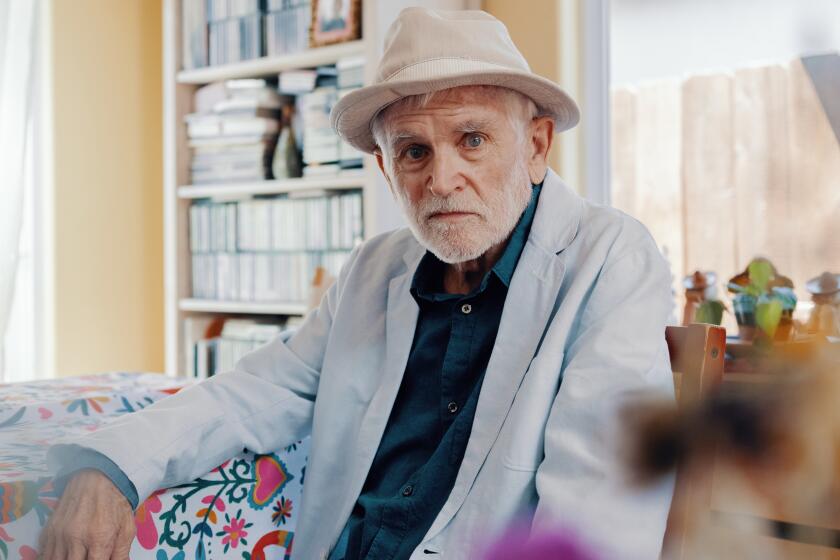Unending Blues by Charles Simic (Harcourt Brace Jovanovich: $14.95; 57 pp.)
- Share via
Randall Jarrell once complained that we live in an Age of Anthology. As a poet, he knew the costs and benefits of this. While anthologies can reach wide audiences and may help introduce and promote a poet’s work, they also invariably distort it. Some poets--represented by the same poems over and over again--may even become victims of anthologies, their entire careers permanently frozen in the public mind by one or two selections.
Charles Simic is such a poet. An English professor at the University of New Hampshire and a recent recipient of a MacArthur fellowship, Simic--who was born in Yugoslavia in 1938 and has published eight previous volumes of poetry--is one of the truly imaginative writers of our time.
Most anthologists, however, have concentrated on a handful of brief, brilliant poems about ordinary objects (“Fork,” “My Shoes,” etc.), giving the impression that Simic is primarily a poet of deep vision and small range. But anthologies cannot adequately represent the overall richness of his figurative language. This richness shows up not in isolated poems but in the densely-woven texture of interlocking images that Simic creates from poem to poem.
A book like “Unending Blues” jolts us out of a “set-piece” mentality. It reminds us that a new book of poems can be a literary item in itself and not just a miniature anthology of a poet’s latest efforts. So intertwined are all of the 44 poems in this book that each poem seems to reflect all of the others, an aesthetic accomplishment that becomes apparent only after several re-readings. The impression is of poems without clear verbal boundaries, poems that drift unendingly in and out of each other.
If American poets can be said to fall roughly into two schools--the vocal and the visual--then Simic is primarily a visual poet. In fact, Simic’s own awareness of these two modes of imagination plays a dominant role in the book. It is especially apparent in the lovely interplay of visual and auditory imagery in the volume’s final poem, “Without a Sough of Wind.”
But despite the pun, the “blues” of the title seem more connected to color than song. Deliberately low-keyed in tone, Simic achieves astonishing effects through recurrent imagery. An image in one poem will turn up embedded in another, and yet again in another. The images, moreover, do not repeat themselves exactly. As in some highly inventive computer graphics programs, they keep recurring in new contexts and surprising configurations.
Take the book’s brief opening poem. Considered by itself, “December” seems slight, somewhat journalistic. It consists of a single image: Even in the snow, two derelicts go “carrying sandwich boards--/one proclaiming/the end of the world/the other/the rates of a local barbershop.” The terms of this humorous juxtaposition, however, will branch out into the entire book: A winter chill, snow, street life and reduced circumstances dominate the volume’s imagery. Nested in the image, too, is the interplay of global and local, the universal and the concrete.
But, more important, we see projected from this first poem the problem of signification. The sandwich boards are literally signs; in this instance, signs that point to both the eternal and the everyday. Such signs appear throughout the book, from the various emblems of prophecy to a madwoman on a sidewalk marking X’s on the backs of lovers. There are signs in the clouds, in the stars, in the movement of insects, the call of birds, in ordinary objects.
Though Simic is always alert, as in “First Frost,” to “sign and enigma in the humblest of things,” just what the signs ultimately point to is another matter. Perhaps they merely point to each other in some Escher-like illusion; or possibly, as in “Birthday Star Atlas,” to an awesome infinitude: “The great nowhere, the everlasting nothing.” Or perhaps they signify the poetic afterimages of a once clear religious vision. In any case, the recurring images of blindness, obscurity, darkness, labyrinths and loss give the volume an unmistakable religious dimension.
T. S. Eliot once noted that a poem might be religious not because of the “quality of its faith but because of the quality of its doubt.” The poems in “Unending Blues” suggest a highly meditative frame of mind, an imagination groping for a coherent vision. Such contemplative activity might well be called devotional, even without a discernible theology.
More to Read
Sign up for our Book Club newsletter
Get the latest news, events and more from the Los Angeles Times Book Club, and help us get L.A. reading and talking.
You may occasionally receive promotional content from the Los Angeles Times.







